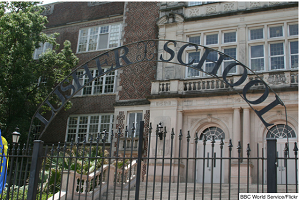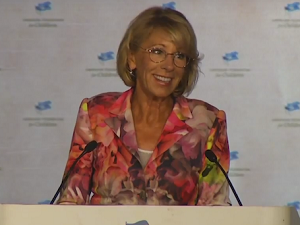Hope Against Hope: Three Schools, One City, and the Struggle to Educate America’s Children
by Sarah Carr
Bloomsbury Press, 2013, $27; 336 pages
 As reviewed by Michael McShane
As reviewed by Michael McShane
Hope Against Hope, Sarah Carr’s vivid, character-driven account of education reform in New Orleans, left me with more questions than answers. But given that the school reform movement prides itself on having the answers, that perspective was quite refreshing.
What is especially refreshing about Carr’s account is that she doesn’t take sides; she speaks negatively of neither education reformers nor traditional educators. In fact, she makes a convincing, yet subtle, argument for educational pluralism.
The book profiles heroic charter school teachers and leaders and chronicles their 80-hour work weeks, their meetings in teacher’s homes to retool instruction because of new data, and their personal commitment to taking students to visit colleges. It also describes more “traditional” educators like Mary Laurie, a high school principal who eschews data on students for relationships with them and “no-excuses” for a kind of personalized tough love.
And then of course there is Geraldlynn, a 9th Grader at KIPP Renaissance High School. Even more than the stories of the teachers and leaders, the story of this KIPP student’s struggle with rigorous behavioral and academic demands humanizes the narrative of education reform. Hearing her side of the story, told a great deal through conversations with her multiple-job-working-yet-still-struggling mother, put a human face on broader debates on education, social policy, and culture.
Mary, Geraldlynn, and the other heroes of this story are battling the odds in a city that struggled even before it was destroyed in one of the worst natural disasters in American history.
But while Carr’s narrative is dense and rich enough to uncover a thousand important issues, my reading led me to consider three central questions:
1. What role should outside culture play in schools?
New Orleans is a silent character in this story. It is praised for its history, its music, its food, its faith, and its community. In almost the same breath, it is decried for its corruption, its violence, its indifference, and its low expectations. While New Orleans is a particularly culturally rich city, many of the same claims could be made about inner cities all across the country.
There is no easy way to wade into debates about a community’s culture and the level to which it should or should not be included in schools. It is fair to say that there are some aspects of any culture that help people succeed in life, and some aspects that hold them back. In the culture of New Orleans, Carr shows both. But one walks away with the realization that, to put it in the terms of the Crescent City, you can’t have Carnival without laisser bon temps roule when you don’t want them to. Managing a school’s culture in relation to the culture of the community that surrounds it is quite possibly one of the most difficult, and most important, tasks of a school leader. But how much do you let it in order to humanize the school before it becomes a negative influence? It is hard to tell.
2. How much discipline is too much?
KIPP and No-Excuses schools like Sci Academy (detailed in the book) pride themselves on clearing out all of the managerial detritus so that teachers can focus on instruction. But even the best plans cannot control the emotions and experiences that students bring with them into school. Terrible things happen to students in low-income communities, like watching friends get shot, or spending nights bouncing from aunt to uncle to grandmother’s house. This causes kids to act out in class. Often, they need more nurturing than they do reprimand, but how do you know when they need the hug and when they need detention, especially at an age when children are already emotionally tempestuous? It is hard to tell.
3. At what point does data lose the forest for the trees?
I think anyone reading this book would conclude that Carr did not wish to set up these various schools as competitors. But it is clear that there are fundamental differences in philosophy between the relationship-driven “data collection” of the Mary Laurie’s of the world and the spreadsheet of interim test score-driven “data collection” of the Ben Marcovitz’s (principal of Sci Academy) of the world. While many of the charter school leaders and teachers are encouraged to develop relationships with children’s families, it is clear that objective metrics like graduation and college attendance rates and student test scores are the ultimate drivers of decisionmaking in the school. But which is right? Which will ultimately lead to better outcomes? It is hard to tell.
There are no easy answers to these questions, and Carr does not attempt to foist some prepackaged set of reforms to answer them. She leaves the story much as it began, in media res, as unfinished as the efforts to solve the educational and social problems of New Orleans.
So what’s my main takeaway here? There is no one school model that works for everyone. There is no combination of personal relationships and data analysis that yields perfect information on the intellectual and social development of every student. There is no golden mean of outside culture to let into the school just like there is no ideal discipline strategy that will give every child just what he or she needs right when he or she needs it.
Just look at Geraldlynn’s family: some of her siblings and cousins thrived at KIPP, others did not. I don’t doubt that some of Mary Laurie’s kids would have done better in Ben Marcovitz’s school, and vice versa.
What is inspiring about the story of New Orleans is not that Ben or Mary is there, but that Ben and Mary are there. Students in New Orleans have better access to different learning models for their different academic as well as socio-emotional needs. If that isn’t beaucoup evidence for the necessity of school choice, I don’t know what is.
-Michael McShane
Michael McShane is a research fellow at AEI and co-author of President Obama and Education Reform: The Personal and the Political.





